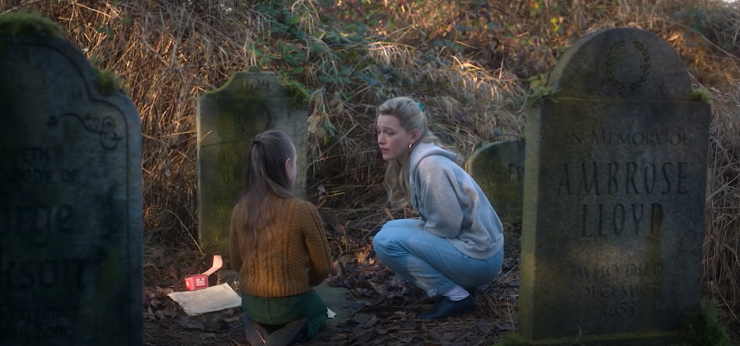Let me open with a spoiler: the scariest monster in Bly Manor are a pair of pegged, tapered, pleated, high-waisted, light wash jeans.
Dani Clayton, Bly Manor’s newly-arrived au pair, wears these things in multiple scenes, and after marathoning the whole show on Friday I spent a sleepless night jolting awake out of nightmares where the jeans were somehow lighter and higher.
Not for the faint of heart.
On a slightly more serious note (but only slightly; those things are horrific) The Haunting of Bly Manor is as creeeepy and stylish as Flanagan’s take on The Haunting of Hill House. It has the same strong emotional core, and, I would argue, stick the landing better than its predecessor. My only true issue is that this is more of a “scary drama” than a true horror story.
The Haunting of Bly Manor is an adaptation of Henry James’ classic ghost story The Turn of the Screw. While I like The Turn of the Screw, it’s nowhere near the visceral favorite that Hill House is for me. What I think an adaptation of Turn has going for it is the simple fact that being set at the end of the Victorian Era, and being such a weird claustrophobic second-hand ghost story leaves an interpreter a huge amount of room to play.
There are a couple of basic questions that interpretations of The Turn of the Screw usually have to ask:
- Are the ghosts objectively real?
- Is a living human attempting to gaslight the governess?
- Are the children somehow part of a conspiracy—either materialist or supernatural—to gaslight the governess?
- Or is the governess dangerously unstable when she gets there?
- Were the children abused in some way?
- Why the hell won’t the uncle come visit?
- What is UP with Mrs. Grose?
Buy the Book
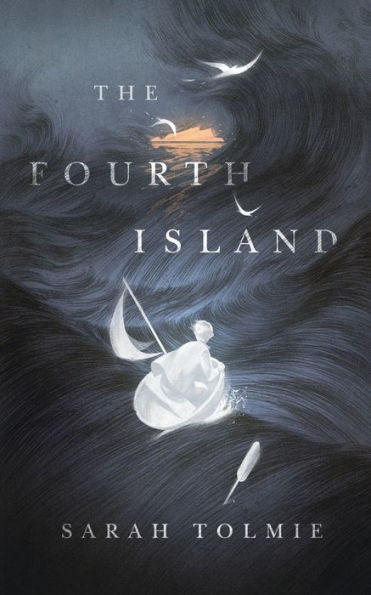

The Fourth Island
Different adaptations have taken different angles on the story. Flanagan’s take is pretty strong, and before I get into anything genuinely spoilery, I’ll just say that I think this is a pretty solid, often frightening show. I didn’t find it nearly as scary as Hill House. What I did love was that it took the subtextual queerness that’s in so much of Henry James’ work and made it text in a way that I found extremely moving. This is much more a love story than a ghost story, and I think if you go in knowing that, rather than looking for jump scares, you’ll have a better time.
Dani Clayton is a schoolteacher from the U.S., who, for various reasons she doesn’t want to talk about, has moved to Britain with no plans to return home. She applies for an au pair job at Bly Manor, and soon finds herself acting as primary caretaker to Miles and Flora, 10 and 8 respectively, who both act a lot older than they ought to, and who are dealing with grief they don’t want to talk about. Miles is also home from boarding school—for reasons no one wants to talk about. Flora’s obsessed with her doll house staying perfectly arranged. Mrs. Grose is usually a ludicrously hypercompetent housekeeper, but sometimes she seems to wander off into secret pockets of her mind—and no, she doesn’t want to talk about that. Owen, the cook, is back home from France… for reasons he doesn’t want to talk about. That leaves Jamie, the gardener, who favors Blondie t-shirts with rolled sleeves, skinny jeans with rolled cuffs, and doesn’t know how to sit in a chair.
You do the math.
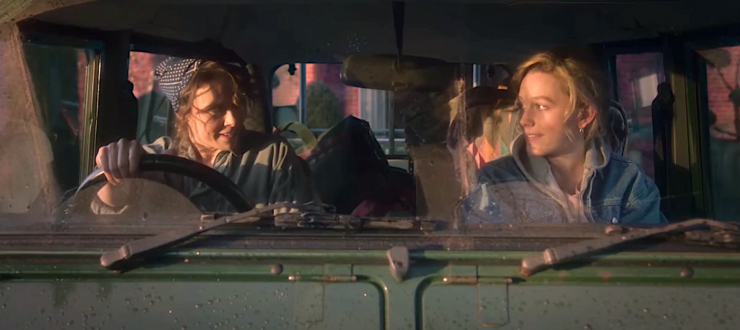
Dani’s time at Bly Manor quickly becomes complicated as she learns about what happened to the previous au pair, begins to suspect that the kids are lying to her about a few things, and finally, begins to notice people who may or may not be there. And meanwhile her boss will not return her calls, and the events that drove her out of the U.S. are preying on her mind.
Mike Flanagan brings a lot of the Hill House gang back, with the very cool result that Bly Manor feels like a repertory theater production in a way, with the actors’ new roles almost creating a conversation with their old ones. Victoria Pedretti, Nell Crain in Hill House, plays Dani the au pair as a tightly wound person who’s used to being on the ball: she rushes around, tilted slight forward, hands half-curled into fists, as though she’s slightly late for a Kristy’s Crushers team meeting but, goshdarnit she’s doing her best. Henry Thomas is back as Flora and Miles’ absent uncle; Kate Siegel, our once and future Theo Crain, is Viola Lloyd; Oliver Jackson-Cohen, who was a standout as the haunted Luke Crain, is now Scottish and dangerously hot as ne’er do well Peter Quint. As for the newer members of the crew: Tahirah Sharif is incandescent as previous au pair Rebecca Jessel; Flora is played by Amelie Bea Smith (AKA Peppa Freaking Pig!) and Miles by Benjamin Evan Ainsworth—both kids do well, especially given that Flora is supposed to be wearing a mask of twee-ness to hide her fear, and Miles is occasionally a sweet kid and occasionally a disturbingly mature one; Rahul Kohli is perfect as Owen; T’Nia Miller is even more perfect as Mrs. Grose; Amelia Eve is perfectest as Jamie the gardener. But maybe my favorite thing? Matthew Holness, GARTH MARENGHI HIMSELF, shows up for a small but pivotal role. But, I do have to mention that because of this there is a wild spectrum of accent work! Some of it’s great, some of it isn’t, I mostly didn’t care because I loved everyone a lot.

Bly Manor holds some hidden ghosts, but they’re not quite as eerie as the residents of Hill House—but that might be simply because I was looking for them? Overall, this show is nowhere near as spooky as Hill House, for reasons I’ll discuss more in a spoiler section below.
Like Hill House, Flanagan lets the story jump through time. Most of the action occurs in 1987, which is evoked through clothes which are period-accurate without tipping into over-the-top ‘80s cosplay. There is one point where the show relies pretty heavily on music cues—but since they’re scoring specific flashbacks it felt to me like the show is consciously trying to create a time capsule feeling, because that’s how the character is remembering things. There was also the perfect perfect perfect detail that British ten-year-old Miles has a large stuffed Dangermouse doll.
From here I’m diving into some spoilers! So if you haven’t watched the whole series yet, and want to, shoo.
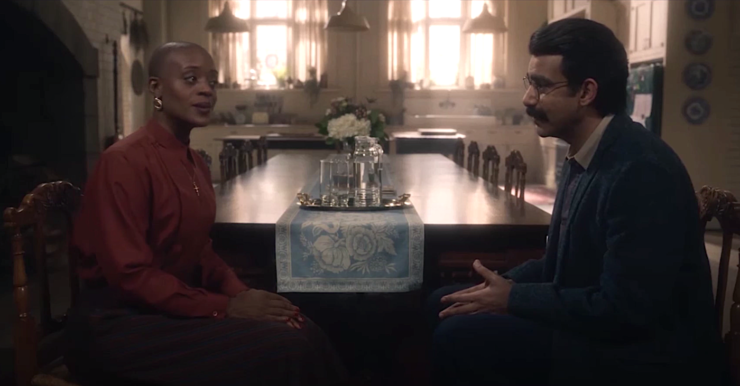
To answer my earlier bullet points: The ghosts are objectively real! Maybe a little too real, as I’ll discuss below. The kids are a mess after all the trauma they’ve lived through, but at some points they seem to be protecting Dani from spirits, while at others they seem to almost welcome possession. These kids do not have an easy time. Dani is possibly being gaslit from beyond the grave by her dead fiancé, but she might just be trapped in a memory loop of her own making? The uncle won’t visit because he’s been… cursed? Kind of? By his brother, or it’s possible that like Dani he’s just trapping himself in a constant round of guilt and self-recrimination.
Are you a fan of the infamous “Bent-Neck Lady” episode of Haunting of Hill House? You know, the episode that finally took us deep into the trauma of Nell, the baby of the Crain family, and crushed all of our hearts like a fucking grape press? Well if you are you are in LUCK, you sick bastard, because there are TWO heart-crushing standalone episodes in Bly Manor!
Flanagan’s answer for what is UP with Mrs. Grose comes in “The Altar of the Dead”. Over the course of an hour, we learn what happened to Mrs. Grose, why she lives full-time at Bly Manor when none of the rest of the help does, why she’s so protective of the house, the kids’ and the memories of the kids’ parents. Also why she doesn’t eat. Why she can’t leave. Why she keeps spacing out. Why her flirtation with Owen feels so terribly doomed. It’s because, as I’m sure a lot of you began to suspect early on, she is dead, dead, deadski. But not just a tormented spirit that came with the house, oh no, she was pushed into a well by Miles, who was possessed by Peter Quint, mere moments before Dani arrived. Meaning that if Dani had just gotten there five minutes sooner Mrs. Grose might have survived to pursue her romance with Owen. In a gorgeous nod to the Turn of the Screw-inspired film The Others, Hannah doesn’t know she’s a ghost. She goes through the motions of her life at Bly, gradually realizing that something terrible is wrong with her. The show visualizes this by sticking close to Hannah’s point of view, and then having her walk through a door into a moment from five years earlier, and relive it, only to walk down the hall into the present day with Dani and the kids, and then turn a corner and find herself back in an argument with Miss Jessell, the previous au pair. At first she’s so fully in each moment that she doesn’t realize anything’s wrong, but the show relentlessly takes us all with her as she becomes frantic. It’s an amazing episode, a beautiful showcase for T’Nia Miller, who plays every moment with an urgency and emotion that made me forget I was watching a show at all. But it’s brutal.
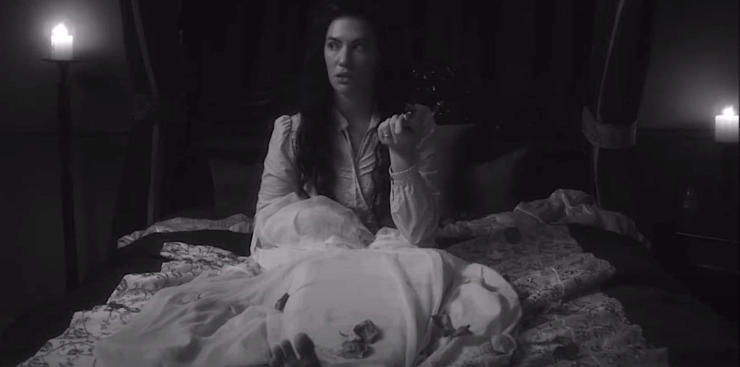
And it’s not even the only episode like that! Because Episode 8, “The Romance of Certain Old Clothes”, takes us into Bly Manor’s cursed past. We learn about the Wingrave sisters, Viola and Perdita, and how they ensnared their cousin, Arthur Lloyd, to marry Viola so they could keep the house after their father died. After a brief happy time, Viola became sick, and locked all of her clothes and jewelry into a trunk for her daughter Isabelle, before descending fully into bitterness and rage. Perdita eventually murdered her sister, and married her widower, and started obsessing about that trunk full of sellable goods. Meanwhile, Viola found herself in a very particular Purgatory—a small room, with only a locked door, a blank window, and a wardrobe of all of her fabulous clothing. She soon realized she was in the trunk, spiritually speaking, trapped alone in a one-woman-show of No Exit. After the long years of Viola waiting for the day when her beloved daughter would open the chest and claim her inheritance, and, Viola thinks, free her from this prison, her murderous sister is the one who opens it. So Viola kills her back. And then Arthur and Isabelle toss the trunk into the lake, and Viola slowly forgets herself and begins her haunting circuit through the house, searching for her lost child and murdering anyone who crosses her path.
And as a standalone ghost story this is great. Between this, Doctor Sleep, and Hill House, Flanagan has proved himself to be a great modern interpreter of death, all these poor people trapped in rooms and chests and repeating moments on an endless loop. But, this also leads into my biggest issue with the series.
As with a lot of horror, the balance between atmosphere and resolution is SO tricky, and I don’t think Bly Manor quite pulls it off. How much do you imply, and how much do you explain? Can there be an explanation of horror that lives up to the sense of dread when no one quite knows what’s going on?
I kept thinking about Tim Burton’s take on Sleepy Hollow. The first hour or so of that film is a fantastic reimagining of the Washington Irving story: the Horseman’s killing spree is portrayed as a supernatural murder mystery; Ichabod Crane is a policeman instead of a schoolteacher; Katrina Van Tassel is a bookish, kindhearted witch. It works well, because Ichabod is still a nerdy outsider who has to try to deal with townsfolk who can’t stand him, and Katrina is still the beautiful, rich belle of the village—but now she has a personality and a skill of her own. For the first hour the film is moody and gothic and genuinely creepy, the mystery itself seems rich, and the movie tells a lovely metastory about magic, faith, and science. But over the course of the last half hour, all that beautiful worldbuilding falls apart as every thread of the plot is picked apart and explained away until the Horseman is reduced to an evil errand boy.
Bly Manor falls victim to a similar fate. As I mentioned above, almost all the bullet points receive neat, satisfactory answers—which somewhat drains the tensions from the last half of the series. “The Romance of Certain Old Clothes”, the episode that unravels why Bly Manor is tormented by ghosts is great—as a standalone. But in the larger framework it connects so many of the dots from previous episodes—what should be a terrifying haunting becomes cause and effect. Peter Quint’s devilish nature is half-explained, but not in a way that tells us something new about him, and the kids’ erratic behavior is explained in a way that validates the governess’s point of view in James’ book without complicating it at all—even though Dani is a huge departure from that version of the governess. Dani, Owen, and Jamie are able to come face-to-face with multiple ghosts and go back to everyday life with their minds mostly unscathed. For me, while I loved huge swathes of the show, it ultimately wasn’t quite dedicated enough to the mystery and uncanniness that you need at the heart of a good horror.
But, in exchange for that, we get a wonderful, heartwrenching queer love story that earns its trauma without wallowing in it or playing out like a stereotypical gay tragedy—and that might be even better right now than getting a solid ghost story.
Having said all of this, I want to end by saying that it was incredibly moving to watch and honest, beautiful love story between two women, especially as a contrast with the possessive love Peter Quint had for poor Rebecca Jessel, especially compared with Henry’s furtive love for his sister-in-law, Charlotte. And especially now, this week, to watch two women declare their love and wear their rings in a time when they couldn’t legally marry? I am a person who tends to treat their emotions like lions and tigers at the far end of a cage. I keep my chair and my whip ready; my top hat may be jauntily askew, but it never falls from my head. But there is a certain scene in this show that is so terribly loving and honest that before I knew what was happening I had a tiger headbutting me from one side while a lion slapped me with one of his huge paws. It’s OK, they both kept their claws in, but the chair went skidding right out of the cage, and who even knows where the whip went. It was all I could do to hang on to my top hat and sob. While Bly House doesn’t quite become the great horror story I initially hoped for, I think the queer love story we got is a far better story to tell.
Leah Schnelbach wouldn’t say no to ghost lions and tigers, however. Come haunt them on Twitter!










